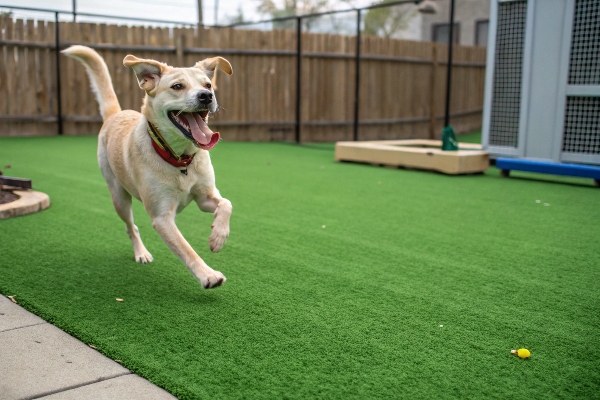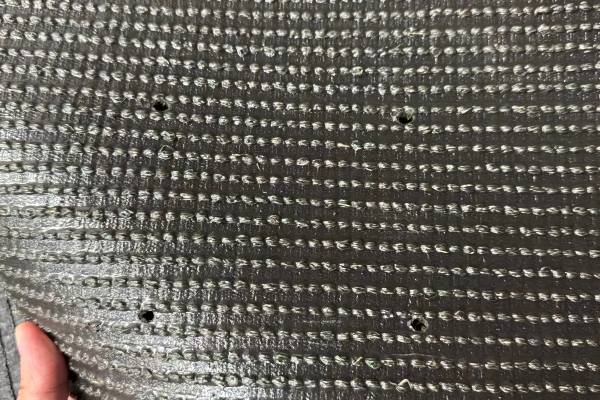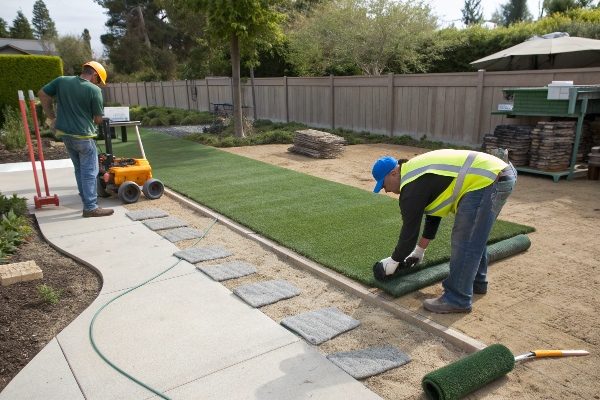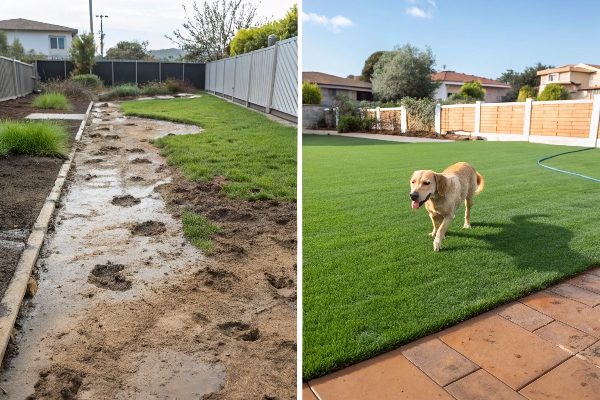Tired of muddy paws and patchy grass in your backyard? A messy yard makes both you and your dog unhappy. Pet turf provides a clean, durable, and beautiful solution for everyone.
Pet turf is the best choice because it gives you excellent drainage, is very durable against digging, and is easy to clean. This means no more mud, fewer pests, and a safe, consistent surface for your dog to enjoy all year.

I have helped many customers who struggle to keep a nice lawn with active dogs. They always deal with torn-up grass, muddy messes after rain, and constant work to fix it. It is a real headache for them. But I have seen how moving to a special pet turf system can change everything. Let’s look at exactly what makes it such a great choice.
What Makes Pet Turf Ideal for Dogs?
Are you worried about your dog’s safety and comfort on artificial grass? Natural grass can hide pests and allergens that harm your pet. Pet turf is designed just for them and offers a safer option.
Pet turf is perfect for dogs because it has a superior drainage system that handles urine well and prevents bad smells. Its strong, non-toxic fibers are soft on paws but tough enough to resist digging. This makes the area clean, safe, and comfortable.

In my early days as a turf engineer, I quickly realized that standard artificial grass was not enough for pets. Dogs have unique needs. We had to design something specifically for them. A proper pet system focuses on three key areas: drainage, durability, and safety. These elements work together to create the perfect space. Let’s break down why these features are so important for your dog.
Superior Drainage
The biggest problem with pets is urine. On natural grass, it creates yellow spots and smells. On standard turf, it can get trapped. Pet turf has a special backing with more drainage holes. This backing allows liquids to pass through very quickly into the sub-base below. This rapid drainage prevents puddles from forming and stops bacteria from growing. It is the key to keeping your yard smelling fresh and clean.
Unmatched Durability
Dogs love to run, dig, and play. This is very tough on a natural lawn. Pet turf is built to handle this. The fibers are made from strong polyethylene, and they are stitched very securely to the backing. I’ve seen dogs try to dig through our pet turf, and they just can’t. The surface remains intact and green.
| Feature | Pet Turf | Natural Grass |
|---|---|---|
| Digging Resistance | Excellent | Poor |
| Wear & Tear | High Resistance | Low Resistance |
| Appearance | Stays Green | Gets Patchy |
| Lifespan | 10-15 Years | Needs Annual Care |
Safety and Comfort
Your dog’s health is the top priority. That is why our pet turf is made from non-toxic, lead-free materials. It is completely safe for them to roll and play on. We also recommend a special infill, like rounded silica sand or zeolite. The infill provides cushioning for their joints and is soft on their paws. It also helps keep the grass blades standing up, making it look and feel more natural.
How to Set Up Pet Turf in Your Backyard?
Thinking about installing pet turf but the process seems too complex? A bad installation can ruin all the benefits. I can show you the key steps for a perfect setup.
To set up pet turf, you need to prepare a solid base. First, clear the area and create a compacted sub-base1 of crushed rock for good drainage. Then, lay the turf, seam the pieces carefully, secure the edges, and add the right infill.

As someone who has overseen hundreds of projects, I can tell you that the most common mistake is poor base preparation. Many people think you can just roll the turf out on top of the soil. This will lead to drainage problems, lumps, and an unstable surface. A great pet turf system is built from the ground up. I always tell my clients that a professional installation is an investment in the performance and longevity of their turf. Let me walk you through the proper steps.
Step 1: Base Preparation
This is the most critical step. You must first excavate the existing soil to a depth of about 3-4 inches. This removes organic material that can decompose and create an uneven surface. Next, you will add a layer of crushed stone, often called an aggregate base. This layer provides the structural support and is the main component of your drainage system. We then use a plate compactor to make this base flat, smooth, and very firm.
Step 2: Laying and Seaming the Turf
Once the base is ready, we roll out the pet turf. It is important to lay all the pieces so the grass blades face the same direction. This ensures the color and texture look consistent across the entire area. We then carefully trim the edges with a sharp utility knife to fit the shape of your yard perfectly. Where two pieces of turf meet, we use a special seaming tape and a strong adhesive. This process creates a bond that is invisible and strong enough to withstand active dogs running over it.
Step 3: Securing and Adding Infill
To prevent the edges from lifting, we secure the entire perimeter of the turf with long, galvanized nails or landscape spikes. This ensures your dog cannot pull up the corners. The final step is to add the infill. For pets, I always recommend an antimicrobial or odor-absorbing infill like zeolite. We spread it evenly over the turf and then use a power broom to work it down into the base of the fibers. The infill helps the blades stand up, protects the backing from UV rays, and adds weight to keep the turf in place.
Is Pet Turf Worth the Investment?
The upfront cost of pet turf can seem high. It might make you question if it is a good use of your money. But we should look at the long-term value it brings.
Yes, pet turf is worth the investment. The initial cost is higher than natural grass, but you save a lot of money over time. You stop paying for water, fertilizers, pesticides, and lawn equipment, and your yard stays perfect for years.

As a business owner, I always look at the return on investment. With pet turf, the numbers are very clear. But the value is not just about money. It is also about the time you get back and the peace of mind you gain. One of my clients used to spend every weekend working on his lawn. He was frustrated with the constant battle against his two dogs. After installing pet turf, he told me it was the best money he ever spent on his home. He finally had his weekends back to enjoy with his family and pets, not work for them.
Upfront Cost vs. Long-Term Savings
Let’s compare the costs directly. A natural lawn has a lower initial cost for seed or sod. But the expenses continue every year. You have to pay for water, a lawnmower and fuel, fertilizers to keep it green, and pesticides to control insects. You also have to repair patches your dog destroys. These costs add up quickly. Pet turf has a higher cost for installation, but after that, the maintenance costs2 are almost zero. You stop watering. You stop mowing. You stop buying chemicals.
A Table of Costs
Here is a simple breakdown of how costs can look over a 10-year period:
| Cost Factor | Natural Lawn (10 Years) | Pet Turf (10 Years) |
|---|---|---|
| Installation | Low-Medium | High |
| Watering | High | None |
| Equipment/Fuel | Medium | None |
| Fertilizers/Pesticides | Medium | None |
| Lawn Repair | High | Low (minimal) |
| Total Value | High ongoing costs & labor | Low ongoing costs, no labor |
Intangible Benefits
The value of pet turf goes beyond just money. Think about the benefits that do not have a price tag. You get a cleaner house because your dog is not tracking in mud and dirt. You have a safer play area for your children and pets, free from chemicals. You also get back your free time. This allows you to spend more quality time enjoying your yard instead of working in it. These benefits significantly improve your quality of life.
Conclusion
Pet turf is a smart investment. It creates a durable, clean, and safe play area for your dog while saving you time and money on long-term maintenance.
_画板-1.png)
_画板-1.png)